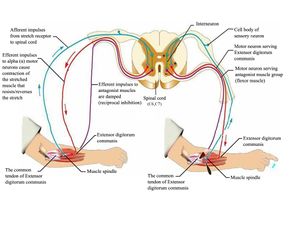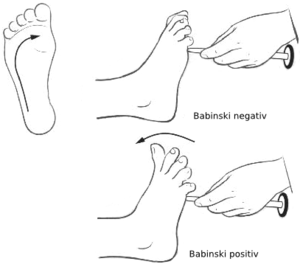what part of the reflex hammer is used to tap on tendons or ligaments
Reflexes
Jump to:navigation, search
Spinal Reflex/The Reflex Arc [edit | edit source]
Areflex is an involuntary and virtually instantaneous movement in response to a stimulus. The reflex is an automatic response to a stimulus that does not receive or need conscious thought as it occurs through a reflex arc. Reflex arcs human activity on an impulse before that impulse reaches the encephalon.[1]
Relex arcs can be
- Monosynaptic ie contain just ii neurons, a sensory and a motor neuron. Examples of monosynaptic reflex arcs in humans include the patellar reflex and the Achilles reflex.
- Polysynaptic ie multiple interneurons (besides called relay neurons) that interface between the sensory and motor neurons in the reflex pathway.[two]
 Illustration of the reflex arc.
Illustration of the reflex arc.
Video of reflex arc
Types of Reflexe [edit | edit source]
- Superficial reflexes: Plantar response, abdominal reflex, cremastic reflex, corneal reflex[3]
- Deep reflexes: Biceps, Brachioradialis, Triceps, Articulatio genus jerk, and ankle jerk.
Reflex Testing [edit | edit source]
Deep Tendon (muscle stretch) Reflexes [edit | edit source]
Evaluates afferent nerves, synaptic connections within the spinal cord, motor nerves, and descending motor pathways. Lower motor neuron lesions (eg affecting the anterior horn cell, spinal root or peripheral nerve) depress reflexes: upper motor neuron lesions increase the reflexes.
Reflexes tested include the following:
- Biceps (innervated by C5 and C6)
- Radial brachialis (by C6)
- Triceps (by C7)
- Distal finger flexors (past C8)
- Quadriceps human knee jerk (by L4)
- Talocrural joint jerk (by S1)
- Jaw jerk (by the 5th cranial nerve)
Technique for testing reflexes [edit | edit source]
- The musculus group to exist tested must be in a neutral position (i.eastward. neither stretched nor contracted).
- The tendon fastened to the muscle(s) which is/are to exist tested must be conspicuously identified. Place the extremity in a positioned that allows the tendon to be easily struck with the reflex hammer.
- To easily locate the tendon, ask the patient to contract the musculus to which information technology is attached. When the musculus shortens, yous should be able to both see and feel the cord like tendon, confirming its precise location.
- Strike the tendon with a single, brisk, stroke. Yous should not arm-twist pain.
This grading system is rather subjective.
- 0 No evidence of contraction
- 1+ Decreased, merely nevertheless present (hypo-reflexic). Hyporeflexia is generally associated with a lower motor neuron deficit (at the alpha motor neurons from spinal cord to muscle) eg Guillain–Barré syndrome
- 2+ Normal
- iii+ Super-normal (hyper-reflexic) Hyperreflexia is often attributed to upper motor neuron lesions eg Multiple sclerosis
- four+ Clonus: Repetitive shortening of the muscle after a single stimulation[four]
Annotation any asymmetric increase or depression. Jendrassik manoeuvre can be used to augment hypoactive reflexes ie the patient locks the easily together and pulls vigorously apart equally a tendon in the lower extremity is tapped or tin button the knees together against each other, while the upper limb tendon is tested.
The video below illustrates the testing of the deep tendon reflexes
[5]
Pathologic reflexes [edit | edit source]
Pathologic reflexes (eg, Babinski, rooting, grasp) are reversions to primitive responses and indicate loss of cortical inhibition.
Other reflexes [edit | edit source]
Clonus (rhythmic, rapid alternation of muscle wrinkle and relaxation caused past sudden, passive tendon stretching) testing is done by rapid dorsiflexion of the human foot at the ankle. Sustained clonus indicates an upper motor neuron disorder.[six]

Significance of Superficial reflexes in Physiotherapy [edit | edit source]
- Abdominal reflex-is stimulated past stroking effectually the abdomen which helps in determining the level of CNS lesion.[7]
- Cremastic reflex-It is elicited when the inner office of thigh is stroked in males (Geigel reflex is the counterpart in females). This reflex helps in evaluation of astute scrotal hurting and assessing for testicular torsion(associated with loss of reflex)[8].
- Corneal reflex-Information technology is elicited by gentle stroking on the cornea with a cotton swab. This reflex mainly helps in knowing the damage peripherally to either the trigeminal nerve (V) or facial nerve (VII) nerve will disrupt the corneal blink circuit. [9]
- Plantar reflex-abnormal reflex indicates metabolic or structural abnormality in the corticospinal organization upstream from the segmental reflex.[10]
Reference [edit | edit source]
- ↑ Wikipedia. Reflex. Bachelor from: https://en.wikipedia.org/wiki/Reflex (last accessed 21.four.2019)
- ↑ Lumen. Reflexes. https://courses.lumenlearning.com/boundless-ap/chapter/reflexes/ (last accessed 21.4.2019)
- ↑ http://teachneuro.blogspot.com/2013/01/the-corneal-or-glimmer-reflex.html?grand=ane
- ↑ University of California. The neurological examination. Available from: https://meded.ucsd.edu/clinicalmed/neuro3.htm (final accessed 21.4.2019)
- ↑ Justin Vaida Deep tendon reflexes. Available from: https://world wide web.youtube.com/lookout man?five=H1b-iKf2CuY (last accessed 21.4.2019)
- ↑ MSD Manual. How to access reflexes. Bachelor from: https://world wide web.msdmanuals.com/professional person/neurologic-disorders/neurologic-test/how-to-assess-reflexes (last accessed 21.4.2019)
- ↑ https://en.wikipedia.org/wiki/Abdominal_reflex
- ↑ https://www.ncbi.nlm.nih.gov/books/NBK513348/#
- ↑ https://www.ncbi.nlm.nih.gov/books/NBK534247/
- ↑ https://www.ncbi.nlm.nih.gov/books/NBK397/
Source: https://www.physio-pedia.com/Reflexes
0 Response to "what part of the reflex hammer is used to tap on tendons or ligaments"
Post a Comment